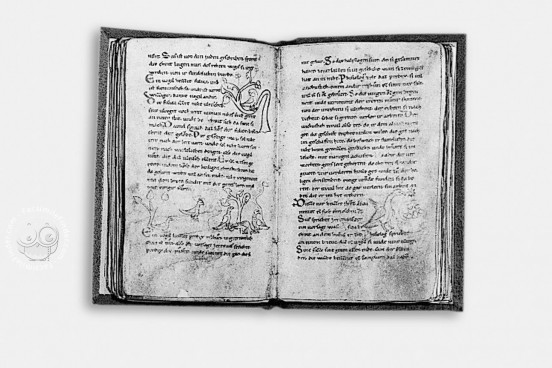The Millstatt Genesis and Physiologus manuscript, an illustrious example of early Middle High German literature, stands as a cornerstone of medieval Germanic cultural heritage. The illustrated codex was probably crafted around 1200 in the southern Bavarian region, particularly Carinthia, and comprises 167 preserved sheets, featuring eight rhyming poems across 6,062 verses. The manuscript owes its name to the Benedictine Monastery of Millstatt, despite indications that its actual creation took place elsewhere within the southern Bavarian sphere.
Medieval Germanic Lore and Spirituality
As a pivotal collective manuscript, the Millstätter Manuscript encompasses a significant portion of early Middle High German literature. Its most notable sections include the Millstätter Genesis, Millstätter Physiologus, and Millstätter Exodus, which together form the core of the manuscript. The Millstätter Genesis offers a rhymed rendition of the biblical Genesis in Old German, standing out for its literary significance. The Physiologus section provides a unique medieval zoological textbook in rhyme, describing twenty-nine animals with Christian allegorical interpretations. Following these, the Exodus part narrates the early chapters of the biblical Exodus story.
These primary texts are supplemented by two sermons on law and marriage, a lamentation for sins, and an interpretation of the Lord's Prayer, culminating in the opening verses of "The Heavenly Jerusalem." This collection of vernacular spiritual poems was intended for a noble audience, reflecting the manuscript's cultural and educational purposes.
119 Colored Pen Drawings of High Artistic Interest
The Millstätter Genesis and Physiologus is particularly noted for its 119 colored pen drawings, attributed to the Salzburg painting school of the twelfth century. These illustrations have garnered art historical interest, linking the manuscript to a broader European context of biblical representation, including the Cotton Genesis fragments in the British Library, the mosaic cupola at St. Mark’s in Venice, and Carolingian bibles from Tours. This connection underscores the manuscript's value in studying the Genesis cycle and the Physiologus's iconography, offering insights into the medieval interpretation of biblical and zoological texts.
From Monastery to Archive
The Millstatt Genesis and Physiologus journey through time saw it becoming part of the Millstatt Societas Jesu in 1598, following the holdings from the Benedictine monastery in Millstatt. A property entry from the seventeenth-century documents this transition. With the dissolution of the Jesuit order in 1773, the manuscript eventually found its way into private hands in 1845, in Carinthia, before being acquired by the Association for History and Regional Studies of Carinthia in Klagenfurt. Today, it is preserved in the Carinthian State Archives under the signature Cod. GV 6/19, maintained by the History Association for Carinthia.
We have 1 facsimile edition of the manuscript "Millstatt Genesis and Physiologus": Die Millstätter Genesis- und Physiologus-Handschrift facsimile edition, published by Akademische Druck- u. Verlagsanstalt (ADEVA), 1967
Request Info / Price
